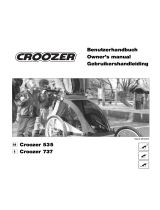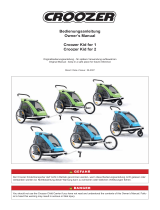
Wir gratulieren Ihnen zum Erwerb dieses hochwertigen Kinder-Fahrradanhängers.
Die Bedienungsanleitung ist Bestandteil dieses Produktes. Händigen Sie diese bei Weitergabe des Produktes an Dritte mit aus.
Sicherheitshinweise!
Lesen Sie diese Hinweise sorgfältig vor der Benutzung und bewahren Sie sie auf.
Wenn Sie diese Hinweise nicht beachten, kann Ihre Sicherheit und die Sicherheit der anderen Verkehrsteilnehmer beeinträchtigt werden.
1. Der Anhänger ist für den Transport von bis zu 2 Kindern bestimmt.
2. Das zulässige Gesamtgewicht des Anhängers darf 40 kg nicht überschreiten.
3. Kinder dürfen erst transportiert werden, wenn Sie selbständig und sicher sitzen können.
4. Die Kopffreiheit (Abstand zwischen behelmter Kopfoberkante und Oberkante des Rahmenaufbaus) des Kindes muss mindestens 100 mm
betragen, um die Verletzungsgefahr des Kindes bei Überschlag zu verringern.
5. Die Kinder müssen während der Fahrt immer angegurtet sein.
6. Lassen Sie die Kinder nie unbeaufsichtigt im Kinderanhänger.
7. Nehmen Sie keine technischen Veränderungen am Anhänger vor.
8. An der Deichsel dürfen keine Zusatzlasten angebracht werden.
9. Höchstgeschwindigkeit 16 km/h.
10. Benutzen Sie den Anhänger nicht auf sehr steinigen oder anderweitig gefährlichen Straßen.
11. Verhalten Sie sich im Straßenverkehr immer äußerst vorsichtig, um eine Gefährdung zu vermeiden.
12. Bei Fahrten mit dem Kinderanhänger sollten Sie darauf achten, dass der Bremsweg und der Wendekreis größer sind als beim Solo-Fahrrad.
13. Der Fahrer des ziehenden Fahrrades sollte mindestens 16 Jahre als sein und sich in einer guten Verfassung benden.
14. Der Fahrer und die Kinder sollten während der Fahrt einen Helm tragen.
15. Es können bis zu 2 Kinder gleichzeitig transportiert werden. Beim Transport von einem Kind ist dieses in der Mitte der Sitzbank zu platzieren.
16. Wahlweise kann eine behinderte Person transportiert werden. In diesem Fall kann von der Altersbeschränkung abgesehen werden.
17. Achten Sie darauf, dass das ziehende Fahrrad sich in einem technisch einwandfreien Zustand bendet.
18. Es wird empfohlen, das ziehende Fahrrad mit Rückspiegeln auszurüsten.
19. Kontrollieren Sie vor jeder Fahrt den einwandfreien Sitz aller Teile, besonders die Befestigung der Deichsel und der Räder.
20. Das Verdeck muss während der Fahrt zum Schutz der Kinder vor Verletzungen durch Straßenschmutz und kleine Steinchen immer
geschlossen sein.
21. Legen Sie Ihrem Kind immer die Sicherheitsgurte an.
22. Achten Sie darauf, dass die Sicherheitsgurte korrekt eingestellt und befestigt sind.
23. Für fremde Zubehörteile kann keine Haftung übernommen werden.
24. Es dürfen nur Fahrräder als Zugfahrzeug verwendet werden, in deren Bedienungsanleitung dieses ausdrücklich vom Hersteller des Fahrrades
erlaubt ist. Achtung: Stellen Sie vor der Benutzung sicher, dass das Fahrrad zum Ziehen dieses Anhängers geeignet ist!
25. Der Fachhändler sollte die Verzögerung des Zuges überprüfen, damit die folgenden geforderten Werte eingehalten werden.
Verzögerung des Zuges (mittels Vollverzögerung) mit einer Gesamtmasse von 140 kg.
Vorderradbremsen: a 3,4 m/s2 (trocken) a 2,2 m/s2 (nass)
Hinterradbremse: a 2,2 m/s2 (trocken) a 1,4 m/s2 (nass)
26. Die zulässige Gesamtmasse des ungebremsten Anhängers darf nicht mehr als 40 kg betragen.
27. Machen Sie sich mittels Gewichten (max. Zuladung) im Anhänger, mit dem veränderten Fahrverhalten des Zuges, an einem ungefährlichen
Ort, vertraut. Üben Sie besonders Kurvenfahren, Befahren von Gefällstrecken und Steigungen, Gefahrbremsungen und Anfahren mit dem
Fahrradgespann auf unterschiedlichen Fahrbahnoberächen.
28. Montieren Sie zur besseren Erkennung des Fahrradgespanns den mitgelieferten Wimpel.
29. Achten Sie, bevor Sie das Fahrradgespann benutzen, auf ausreichenden Luftdruck in den Reifen, da sich das Fahrverhalten des Gespanns,
mit unzureichendem Luftdruck in den Reifen, verschlechtern kann.
30. Bei angekoppeltem Anhänger besteht die erhöhte Gefahr des Kippens des Zugfahrrades im Stand. Achten Sie vor allem bei beladenem
Gepäckträger auf einen sicheren Stand des Fahrrades (besonders bei Verwendung eines Kindersitzes ist Vorsicht geboten). In diesem Fall
empfehlen wir einen Doppelständer. Betätigen Sie bei abgestelltem Zugfahrrad zudem immer die Feststellbremse des Anhängers, insbesonde-
re vor dem Ein- und Aussteigen des Kindes.
31. Die Leuchten sind nur bei Betrieb mit Akkus StVZO-konform. Stellen Sie vor jeder Fahrt sicher, dass sich die Beleuchtung in tadellosem Zustand
bendet und die Akkus (nicht im Lieferumfang enthalten) über ausreichende Energie verfügen. Stellen Sie außerdem sicher, dass sich die
Reektoren (2 Front-, 2 Rück- und 4 Speichenreektoren) in einwandfreiem Zustand benden.
Achtung: Bitte befolgen Sie die örtlichen Verkehrsregeln, während Sie das Fahrrad mit Anhänger auf öffentlichen Straßen bewegen!
32. Deichsellast mind.: 35 N / Deichsellast max.: 45 N
Technische Daten:
Gewichte:
Das Leergewicht des Anhängers beträgt: 15,7 kg
Zulässiges Gesamtgewicht: 40 kg
Maximalgewicht pro Kind: 9 kg (bei Transport eines Kindes: 18 kg) + 5 kg Gepäck
Maximale Gesamt-Zuladung: 23 kg
Garantiehinweise:
Es gelten die gesetzlichen Garantiebestimmungen!
Wartung und Reparatur:
Bei starker Beanspruchung des Anhängers müssen alle Teile regelmäßig überprüft und bei Verschleiß oder Beschädigung ausgetauscht werden. Eine
Reparatur beschädigter Teile ist nicht gestattet. Beschädigte Teile müssen durch Originalteile ersetzt werden. Nach den ersten 10 Betriebsstunden sollten
alle Schrauben, Muttern usw. nachgezogen werden. Vor jedem Fahrtantritt ist das gesamte Gespann auf einen ordnungsgemäßen Zustand zu überprüfen.
Hergestellt für:
Inter-Union Technohandel GmbH · Klaus-von-Klitzing-Straße 2 · 76829 Landau · Germany · Telefon: 06341-2840 · www.inter-union.de
Stand: 01.16
Bedienungs- und Sicherheitshinweise
D
86388-FIS-IM-V03-INT-OEF.indd 2 07.01.16 10:21





















